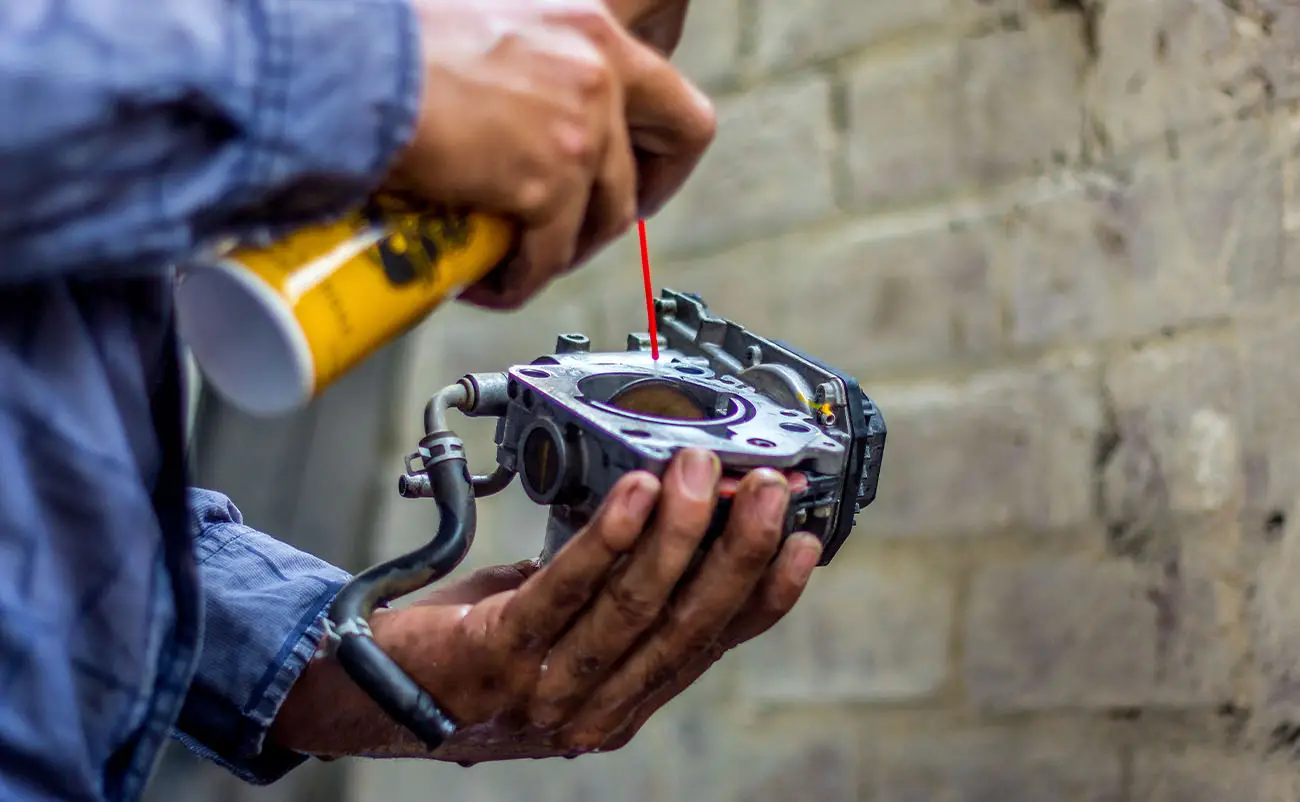Your car’s throttle body controls the amount of air entering the intake system. When you press the gas pedal, the throttle body opens and allows more air into the system. Therefore, you can see that the throttle body has a direct effect on the engine’s performance. When the throttle body gets dirty or becomes clogged with grime and buildup, the engine’s performance suffers. Cleaning the throttle body is not something that must be done very often, but it can be necessary for vehicles with 75,000 miles or more. Throttle body cleaning is not an incredibly complex task, and you can perform this task without removing the part from the car. Keep reading as we tell you all the dirty throttle body symptoms and how to clean a throttle body without removing it.
Table of Contents
What Is A Throttle Body?
We have already mentioned that the throttle body controls the amount of air flowing into the engine as it runs. It is connected to the gas pedal with a mechanical linkage in most cars, although some newer cars use a throttle position sensor and an electrical actuator motor to control the opening of the throttle body.
The further you press the accelerator, the wider the throttle plate inside the throttle body opens. This allows the air intake to flow more air into the combustion chamber. The car’s computer determines the proper amount of fuel for the fuel injectors to spray into the combustion chamber based on the amount of air flowing into the system. If the throttle body becomes dirty, the car’s computer will think that more air is flowing into the system than it really is. This will cause too much fuel to be dumped into the combustion chamber, and this condition can lead to many different problems. We will discuss the symptoms of a dirty throttle body in more detail in the next section.
Symptoms Of A Dirty Throttle Body
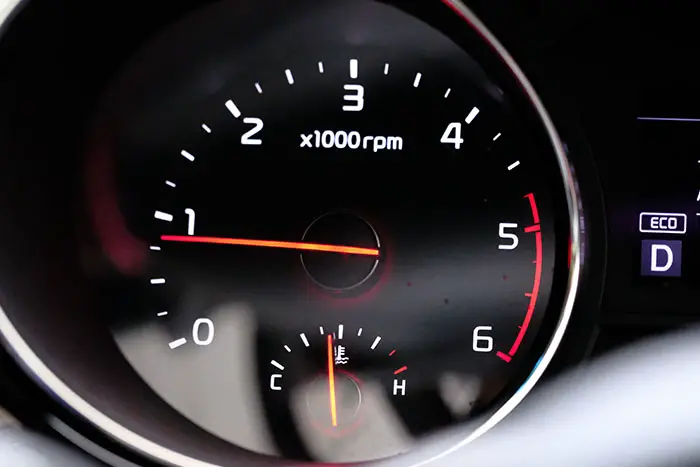
If you are already planning to clean your throttle body, you probably suspect that it is dirty. But how can you tell when it is time to perform this cleaning? There are a few symptoms that you can watch for that might point to a dirty throttle body. Here are the most common symptoms.
— Rough Idling
A rough idle is usually one of the first signs that your throttle body may need cleaning. At idle, the throttle plate is nearly completely closed. The idle control valve located inside the throttle body allows the right amount of air into the system for proper idling. However, if the throttle body is dirty, this process does not work correctly. Airflow may be blocked, and a blockage will cause a noticeable problem at idle. It is also possible that the idle control valve itself has become dirty.
There are a few other problems that might cause a rough idle, like a dirty air filter or dirty fuel injectors. When you experience this symptom, it is sometimes a good idea to go ahead and perform a full tune-up, including a new air filter, new spark plugs, fuel system cleaning, catalytic converter cleaning, and throttle body cleaning.
— Engine Stumbling
When you press the gas pedal, you expect your engine to respond immediately. However, if you have a dirty throttle body, you might find that your engine stumbles when you quickly press the accelerator. The reason this happens is that the car’s computer will immediately spray more fuel into the combustion chamber when the gas pedal is pressed. However, a dirty throttle body may prevent enough air from entering the intake manifold. A lack of air can lead to engine misfires, engine stumbling, or even a check engine light. If your engine stumbles when you press the gas, it might be time for a throttle body cleaning. This symptom can also point to a faulty throttle position sensor in some cases.
— Poor Fuel Economy
Your car’s engine usually runs quite efficiently. The computer sprays the precise amount of fuel into the combustion chamber that is required for optimum performance. However, a dirty throttle body can throw this perfect balance into disarray. When you press the gas pedal, the computer will think that more air is entering the system. However, a dirty throttle body may be preventing some of this airflow. Therefore, more fuel than necessary will be used. This will cause your air/fuel mixture to be too rich, and your car will burn more gas than usual. If you start to notice your fuel economy going down, it could be a sign that your throttle body needs cleaning.
Proper Steps For Throttle Body Cleaning
If you have experienced any of the symptoms discussed above, you are probably now wondering how to clean the throttle body. Performing this cleaning procedure can get your car running smoothly and efficiently again. Here are the steps you need to take to complete this procedure correctly.
1. Gather Tools And Prepare The Vehicle
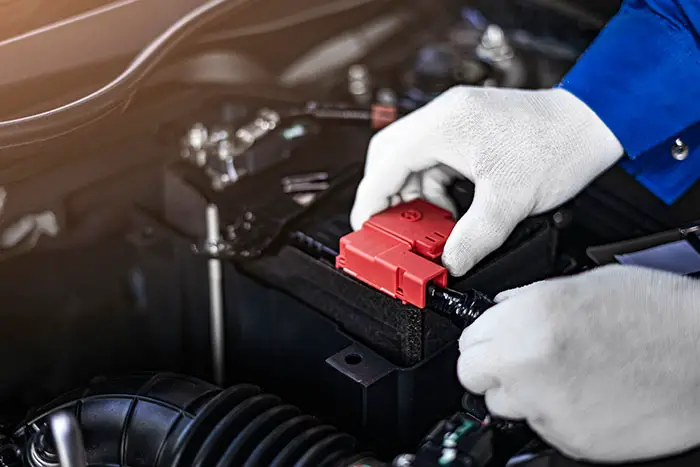
The first step in the process is to gather the appropriate tools and prepare the vehicle for the job. Go ahead and get some shop rags or paper towels, flat and Phillips-head screwdrivers, a can of throttle body cleaner, gloves, wrenches, and sockets. Park your car on a level surface, set the parking brake, and go ahead and disconnect the negative battery terminal. Since there are several electrical connections and sensors present around the throttle body, you will want to ensure that the battery is disconnected before you start the cleaning process. Disconnecting the battery protects these electrical components, and it protects you from getting shocked.
2. Label And Remove Hoses
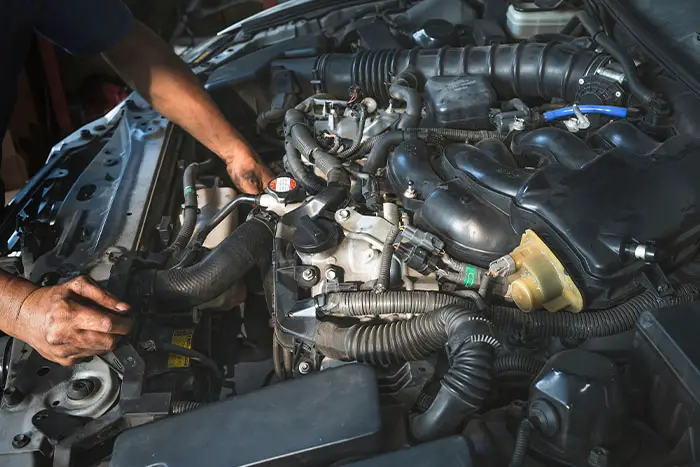
Once you have completed the prep work, it is time to dive into the cleaning process! You will first need to locate the throttle body and label the hoses that will be removed. Labeling these hoses before removal will ensure that you put things back together correctly. You can start at the air cleaner and follow the air duct to the throttle body. You will need to remove the air duct from the throttle body. This hose may be held on by a hose clamp or by a quick connector. Be careful not to damage the mass air flow sensor (MAF) during this process. This sensor is typically located in the air duct between the air filter and the throttle body, and you should see an electrical connector on the duct for the sensor. You will need to remove the duct enough so that you can see the inside of the throttle body.
3. Clean The Throttle Body
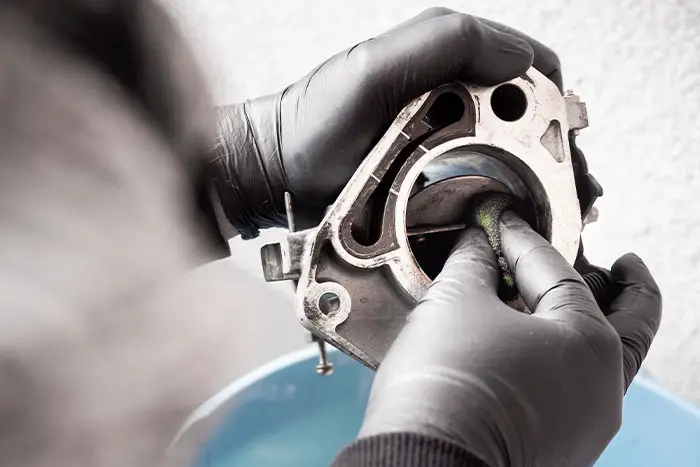
Now it is time to clean all the gunk, varnish, and carbon deposits from the throttle blade and other internal pieces of the throttle body. Now that you have removed all the air ducts from the throttle body, you should have easy access to spray the cleaner into the part. Make sure you are wearing gloves and proper eye protection, and then spray the cleaner into the throttle body. You should use the proper throttle body cleaner, but carburetor cleaner or intake cleaner should do the job too. These cleaners usually come in an aerosol can, so you will simply spray the cleaner into the open duct of the throttle body.
Allow the cleaner to sit for a few minutes so that the solvent can break down the buildup, then wipe the throttle body clean with a rag or paper towel. You might need to use a small toothbrush to remove grime that is stuck in place. Repeat this process until the throttle body is free of dirt and debris. You may choose to use a cotton swab to lightly oil the throttle shaft after you are done with the cleaning. Also, ensure that the cleaner you use is safe for catalytic converters. Replacing a catalytic converter is not cheap, so you don’t want to cause any unintended damage.
4. Reinstall Ducting
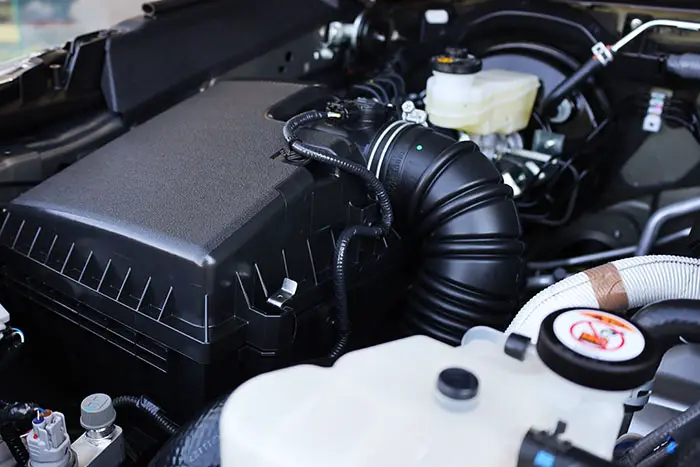
Once the throttle body is clean, you can go ahead and reattach the ducting and hoses that were previously removed. Use the labels that you attached to the hoses so you know where each duct should be connected. Just as you did when removing the ducts, be careful with the sensors and electrical connectors on the ducts. If you damage one of these sensors, you could cost yourself a few hundred dollars to replace the part. Likewise, be careful not to damage any gaskets on the end of the ducts. After the ducting and tubing have been reinstalled, go ahead and reconnect the battery so that the vehicle will be ready to start.
5. Test Drive The Vehicle

Go ahead and start the vehicle and let the engine run for a few minutes. You might notice that the idle is a little rough immediately upon the first startup. This is normal, as it can take the computer a few minutes to recalibrate after the throttle body has been cleaned. Similarly, any leftover carb cleaner in the throttle body can be pulled into the intake and cause the engine to sputter for a few moments. After the engine has warmed up, go ahead and take the car for a test drive. If the throttle body was really dirty, you should notice an improvement in engine performance and drivability. Now you have successfully completed a DIY throttle body cleaning!
Best Throttle Body Cleaners
By now, you are probably ready to clean your car’s throttle body and are wondering which throttle body cleaner is best. Here are the four best cleaners that you can find at your local auto parts store.
— CRC Throttle Body And Air-Intake Cleaner
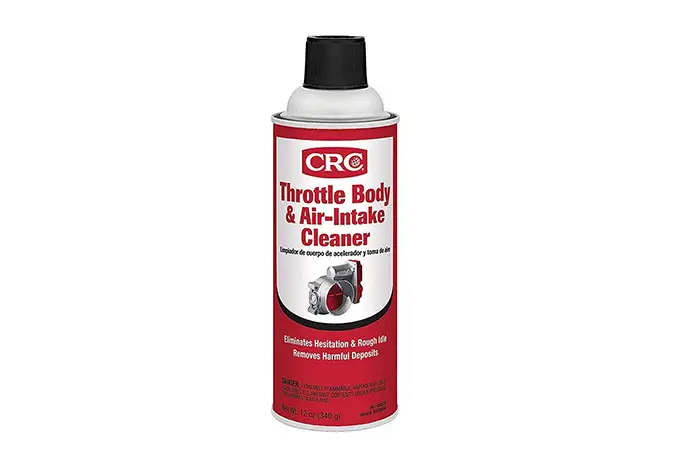
This product from CRC is one of the best, and it is safe in all fuel-injection systems. This cleaner will remove varnish, carbon, and gum buildup inside the throttle body. It can improve fuel economy and help resolve any rough idling or sticky gas pedal issues. Using the product is simple, as you only need to spray the cleaner into the throttle body and use a rag to wipe off any excess cleaner.
— WD-40 Specialist Carb/Throttle Body Cleaner
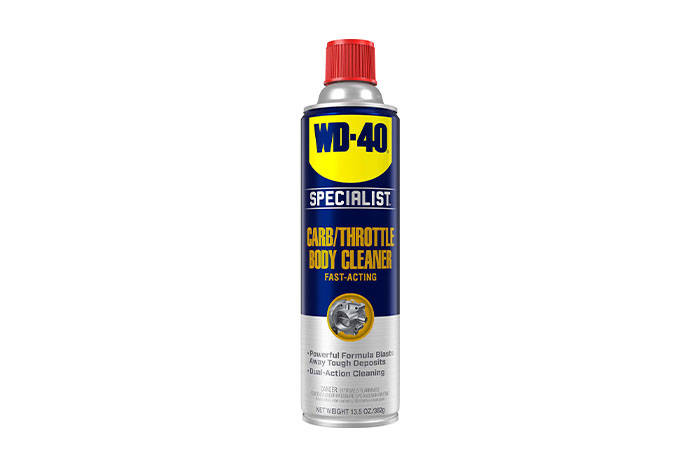
You probably already know that WD-40 makes great products, but you might not be aware of their throttle body cleaner. WD-40’s throttle body cleaner is an excellent option for both fuel-injected systems and carburetors. However, you should only use this cleaner on non-painted metal surfaces. It will not damage O2 sensors or catalytic converters upon incidental contact, and the powerful formula dissolves deposits and blasts them away to leave behind no residue. You should have a fast and easy startup from your engine with a smooth idle after using this product.
— Johnsen’s Throttle Body & Air Intake Cleaner
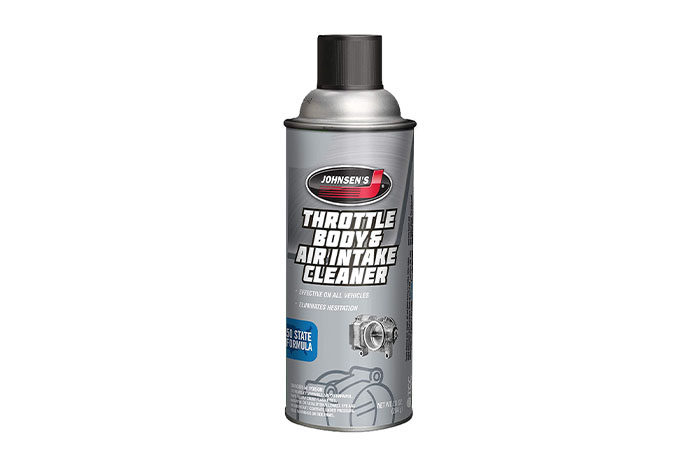
Johnsen’s cleaner is designed to clean your throttle body and other air intake openings in your fuel injection system. This product works on both metal and plastic surfaces, and it will clean carbon buildup and other deposits out of the system. After use, you should see an improvement in hard starting and engine performance. This cleaner also meets VOC requirements in all 50 states, so this is a good option wherever you may live.
— Valvoline Carb And Throttle Body Cleaner
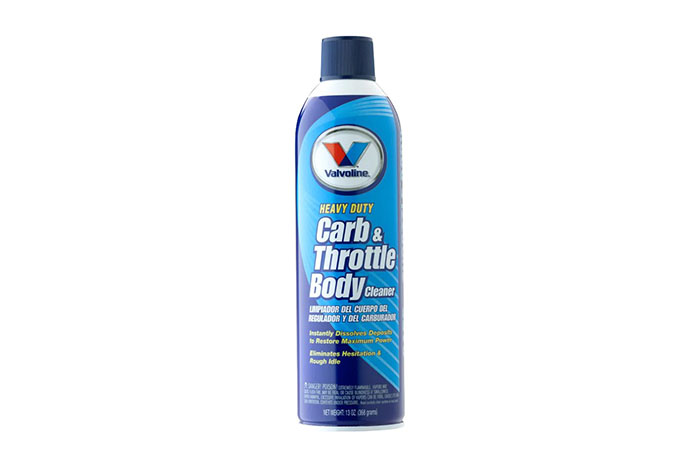
Valvoline is a name that has been trusted in the automotive industry for many years, and its throttle body cleaner does not disappoint. This product is a heavy-duty cleaner that dissolves deposits instantly to restore power back to your engine. You can expect to see an improvement in stumbling and hesitation, as well as fuel economy. This cleaner meets VOC requirements in 49 states, but Valvoline also sells a California-compliant formula as well.
The Bottom Line
A dirty throttle body can lead to many issues, like rough idling, engine stumbling, and poor fuel economy. Once your vehicle reaches 75,000 miles, it is likely time to start thinking about a throttle body cleaning. Luckily, this is something that you can do yourself in most cases. Although you have to remove the air duct, you do not need to remove the throttle body itself. Simply expose the inside of the throttle body, spray the cleaner into the part, and wipe it clean. The process is simple, and you should notice an immediate improvement in your engine’s performance.
Frequently Asked Questions
Can I clean my throttle body myself?
Yes, you can clean the throttle body yourself on most vehicles. In fact, you can perform this cleaning without removing the part from the car. Simply disconnect the air duct from the throttle body and spray the cleaner into the part. Use a small brush or rag to remove stuck debris, and continue spraying cleaner and wiping the inside of the throttle body until it is clean. Reattach the air duct and start your vehicle to see how much difference the cleaning made.
Does cleaning the throttle body make a difference?
Yes, cleaning the throttle body makes a difference in your engine’s performance. The dirtier your throttle body is, the more of a difference you will likely see. If you already notice symptoms, like a rough idle, poor fuel economy, or engine sputtering, you will probably see an immediate difference after the cleaning. Your engine should run smoother, and you should see an increase in fuel economy.
When should I clean my throttle body?
Generally, you should clean your throttle body around 75,000 miles. If you are not experiencing any symptoms of a dirty throttle body, you can wait longer to perform the cleaning. However, as soon as you start experiencing symptoms, you should go ahead and perform the cleaning. The process is pretty quick, and a can of cleaner will only cost you about $10. This is a cheap maintenance item that you can perform yourself, and it can really make a difference in how well your engine runs.

